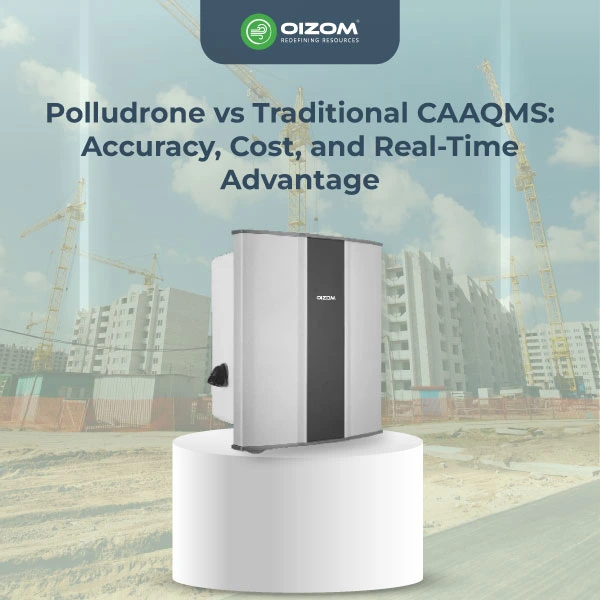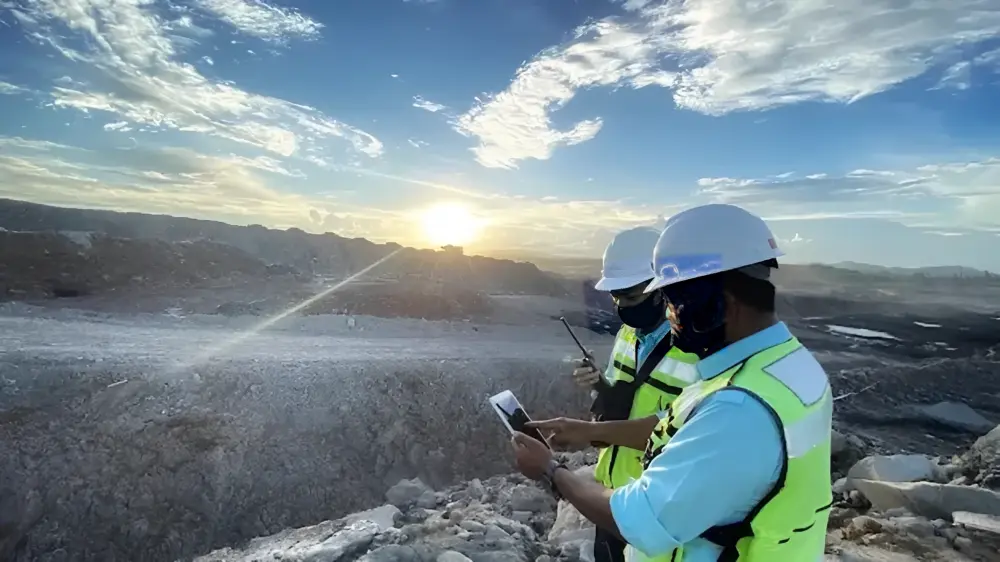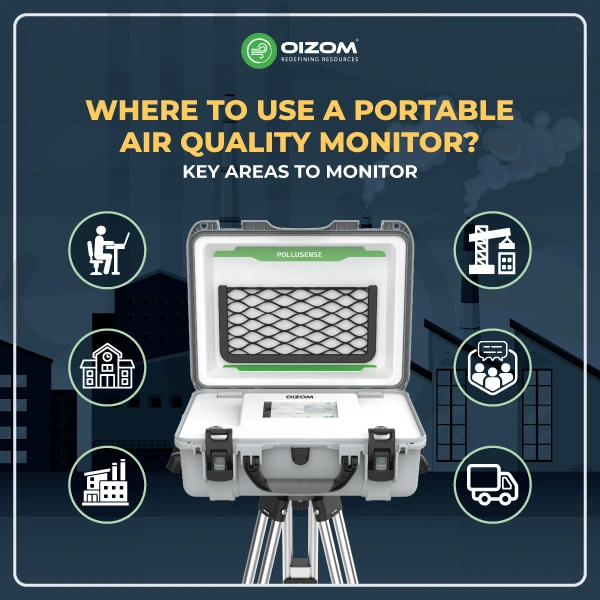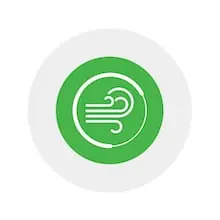Getting accurate air quality data shouldn’t mean waiting hours or breaking your budget.
Traditional Continuous Ambient Air Quality Monitoring Stations (CAAQMS) have long been used for regulatory monitoring. They’re highly accurate, but also expensive, complex to install, and not always practical, especially when you need wide-area coverage or real-time insights.
That’s where Polludrone makes a difference. Built by Oizom, Polludrone is a compact, all-in-one air monitoring system that tracks PM, gases, noise, and weather in real-time. It’s easy to deploy, cost-effective, and designed for continuous outdoor performance, making it a strong alternative to bulky CAAQMS setups.
In this blog, we’ll break down how Polludrone compares with traditional CAAQMS systems in terms of accuracy, cost, ease of use, and real-time data access, so you can decide which solution is the right fit for your environmental monitoring goals.
What is CAAQMS and How Does It Work?
When it comes to regulatory air quality monitoring, CAAQMS (Continuous Ambient Air Quality Monitoring Systems) have long been the industry standard. However, to truly understand how Polludrone compares, it’s essential to first understand what CAAQMS is, how it functions, and why it’s used by pollution control authorities worldwide.
Purpose of CAAQMS in Regulatory Monitoring
CAAQMS stands for Continuous Ambient Air Quality Monitoring System. These systems are widely used by pollution control boards and government agencies to monitor ambient air quality as per national and international standards. The primary objective is to provide regulatory-grade data that can be used for public reporting, policy-making, and enforcement of environmental norms.
Data from CAAQMS stations is often used for compliance reporting, triggering pollution alerts, and supporting legal frameworks like India’s National Ambient Air Quality Standards (NAAQS) or the U.S. EPA standards.
Equipment Used in CAAQMS
CAAQMS units typically include reference-grade analyzers, high-precision instruments that measure pollutants like PM2.5, PM10, SO₂, NO₂, CO, O₃, and NH₃ using standardized methods (e.g., beta attenuation for PM, chemiluminescence for NO₂, Pulsed Fluorescence for SO₂).
These analyzers are housed in climate-controlled shelters or containers to maintain performance stability. Each unit requires a stable power supply, air conditioning, and backup power systems. The data is collected via a data acquisition system (DAS) and transmitted to a central server or regulatory portal for real-time monitoring and archival.
Pros and Limitations
The biggest strength of CAAQMS is its high accuracy and traceability, making it ideal for legal and compliance-grade reporting. However, the trade-offs are significant. These systems are:
- Expensive (often ₹80–100 lakh per station)
- Bulky and needs dedicated infrastructure
- High-maintenance, requiring skilled technicians and frequent calibration
Due to these factors, deploying CAAQMS widely across a city or industrial region becomes impractical. This is where newer, sensor-based alternatives like Polludrone offer a scalable solution, especially for dense networks, hotspot identification, and public information systems.
What is Polludrone and What Makes It Different?
While CAAQMS is designed for regulatory precision, it often comes with heavy infrastructure and cost. Polludrone offers a smart, scalable alternative, providing accurate air quality data in a compact, easy-to-deploy format that’s built for real-world conditions. Let me give a brief about what polludrone is.
Polludrone is Oizom’s advanced air quality monitoring system, designed to measure multiple environmental parameters in real time. Unlike large and complex CAAQMS setups, Polludrone is compact, weather-resistant, and easy to install, making it perfect for both city and industrial use. Whether it’s placed at a busy traffic intersection or around a factory, Polludrone runs 24/7, even in extreme outdoor conditions.
What makes it stand out is its patented e-breathing technology, which pulls in air just like humans breathe, helping sensors collect more accurate data. You can also customize the sensors depending on what you need to monitor, whether it’s for meeting government regulations, tracking emissions, or understanding the health impact of air pollution in a specific area.
Compact and Modular Design
Polludrone is designed to be compact, weatherproof, and easy to install. With an IP66-rated enclosure, it can operate reliably in extreme outdoor environments, whether it’s a dusty industrial site or a humid coastal city. Its modular architecture allows users to select only the parameters they need, making it ideal for both focused studies and city-wide deployments.
The plug-and-play setup means it doesn’t require complex installation or a dedicated shelter. Polludrone can be pole-mounted, wall-mounted, or tripod-installed within minutes, saving time, space, and setup costs.
Multi-Parameter Sensing in One Unit
What sets Polludrone apart is its ability to monitor particulate matter (PM1, PM2.5, PM10, PM100), gaseous pollutants (NO₂, SO₂, CO, O₃, etc.), ambient noise, and meteorological parameters like temperature, humidity, wind speed, solar radiation, and rainfall, all from a single device.
This all-in-one capability allows users to correlate environmental data in real-time, making it easier to identify pollution sources, analyze trends, and take informed action.
A great example of this can be seen in Myanmar, where Nanova Co. Ltd. deployed Polludrone devices to improve air quality monitoring in both urban and industrial regions. The project required real-time insights into multiple environmental parameters without the complexity of installing separate instruments. With Polludrone, they were able to capture PM, gases, noise, and meteorological data through one system, supporting smarter environmental planning and quicker response to pollution events. You can read the full case study here.
Smart Connectivity and Real-Time Data
Polludrone comes with 4G, Wi-Fi, and Ethernet connectivity options, enabling real-time data transmission to Oizom’s cloud platform, Envizom. Users can access live dashboards, set alerts, download reports, or integrate the data into existing systems using secure REST APIs or protocols like Modbus and 4–20mA.
This makes it not only a data collection tool but a real-time decision-making solution, ideal for smart cities, industrial zones, and research institutions alike.
Accuracy Comparison: Polludrone vs CAAQMS
When it comes to air quality data, accuracy is everything. But it’s also important to understand how much accuracy is needed for your specific use case. Here’s how Polludrone compares to traditional CAAQMS in terms of sensing technology, calibration, and real-world performance.

Polludrone vs Traditional CAAQMS – Comparison Table
| Feature | CAAQMS | Oizom’s Polludrone |
|---|---|---|
| Accuracy | Very High (Reference-grade) | High (Lab-calibrated, MCERTS certified sensor) |
| Cost | ₹80–100 lakh+ | < ₹10 lakh |
| Deployment Time | Weeks | Hours |
| Portability | Not Portable | Not Portable |
| Data Access | Centralized Server | Real-Time, Cloud Dashboard - Envizom |
| Maintenance | High Skilled Manpower | Low, Remote Diagnostics |
| Installation | Civil work, HVAC, Power Supply | Pole/Wall Mount, No Shelter Needed |
| Suitable Use Cases | Regulatory Compliance, Legal Reporting | Regulatory Compliance, Legal Reporting |
Sensor Technology and Calibration
CAAQMS systems use reference-grade analyzers like Beta Attenuation Monitors (BAM) for PM and Gas Chromatographs or Chemiluminescence for gases, making them ideal for compliance-grade measurements. However, these analyzers are bulky, power-intensive, and expensive to maintain.
Polludrone, on the other hand, utilizes advanced laser scattering sensors for PM monitoring, as well as electrochemical and NDIR sensors for gases. While not reference-grade, the technology is highly optimized for accuracy, especially in trend detection and hotspot identification.
Want to know how oizom polludrone is calibrated? Then, do read this: Why does Polludrone truly stand out in the air quality monitoring market?
Because we don’t just build monitors; we build trust in data. Every Oizom air quality monitoring device is first calibrated in an ISO/IEC 17025:2017 certified lab using NIST-traceable gas standards, strictly following international guidelines (U.S. EPA Vol II, Section 6.0 Rev.1).
But we don’t stop there.
After lab calibration, each device goes through a second level of testing, collocation with a custom-built reference station equipped with U.S. EPA-designated Federal Equivalent Method (FEM) analyzers. This double-layered approach ensures that Polludrone delivers data you can depend on every single time.
At Oizom, we take data accuracy seriously. Our Polludrone Smart has undergone rigorous field evaluations, including benchmarking by third-party validation programs like AQ-SPEC (Air Quality Sensor Performance Evaluation Center) by South Coast AQMD.
Want to see how it performs in real-world conditions? Click the link above to explore the detailed field evaluation report and discover why Polludrone Smart stands out in accuracy and reliability.
Real-World Accuracy and MCERTS Certification
Polludrone’s PM sensors are MCERTS-certified, meaning they’ve been independently tested and verified for accuracy under real-world conditions. This level of certification is rare among compact ambient monitors and brings trust to the data quality. Third-party validation reports and cross-comparison studies further support its reliability in diverse environments, from traffic-heavy corridors to remote industrial zones.
Suitability for Use Cases
While CAAQMS is mandatory for regulatory compliance in certain scenarios (like CPCB stations or statutory audits), its size and cost make it less feasible for wide-scale deployment. Polludrone fills this gap by offering a cost-effective, scalable, and accurate alternative that’s perfect for smart cities, industries, construction sites, and universities needing actionable air quality data, without the logistical burden.
Cost and Operational Efficiency
Air quality monitoring isn’t just about accuracy; it’s also about practicality, especially when deploying multiple systems across a large area. Let’s break down how Polludrone compares to traditional CAAQMS in terms of installation, maintenance, and total cost over time.
Installation and Infrastructure
One of the most noticeable differences is in how easy Polludrone is to deploy. At under 8 kg, Polludrone is lightweight and pole-mountable, requiring no dedicated housing or HVAC setup. It can be installed on rooftops, poles, or existing infrastructure within hours.
Compare this to a CAAQMS, which typically needs a container-size shelter, a stable concrete base, dedicated AC units, UPS backup, and high-voltage power supply. The civil work alone often stretches installation timelines to several weeks, increasing both time and cost.
Maintenance and Support
Polludrone is built with modular components and supports remote diagnostics, which means troubleshooting can often happen without physical intervention. Calibration can be done in the field using portable kits or remotely with minimal downtime.
CAAQMS, on the other hand, involves specialized service engineers, frequent consumable replacements, and higher manpower costs. A single point of failure, say a BAM malfunction, can lead to full system downtime.
Total Cost of Ownership
Over a 3–5 year period, the total cost of ownership (TCO) for CAAQMS includes high initial hardware costs, calibration gas procurement, maintenance contracts, spare parts, power consumption, and infrastructure upkeep.
Polludrone offers a significantly lower total cost of ownership (TCO), thanks to its energy-efficient operation, minimal maintenance requirements, and scalable architecture. Whether you’re a municipality managing air zones or an industrial facility monitoring emissions, this makes Polludrone a more cost-effective and sustainable choice in the long run.
When to Choose Polludrone Over CAAQMS?
Not every monitoring need demands a reference-grade system. Depending on your project goals, scale, and budget, choosing the right solution can help you achieve accurate insights without overinvesting. Here’s how to decide when Polludrone is the better fit, and when CAAQMS is irreplaceable.

Use Cases for Polludrone
Polludrone is an ideal solution for smart cities, industrial perimeters, construction zones, educational campuses, and temporary deployment sites. Its compact size, quick installation, and multi-parameter capabilities make it perfect for areas that need reliable data without the bulk of a CAAQMS station.
Need to monitor air quality around a highway, detect dust emissions from a construction site, or track PM levels in school premises? Polludrone delivers real-time, actionable insights that help authorities and EHS teams take timely measures. It’s also great for pilot studies, pre-installation assessments, and air quality mapping projects.
A good example of its real-world application is at BARC Mumbai, where Polludrone was deployed to monitor ambient air quality across a high-security, high-sensitivity zone. The solution helped them keep track of PM and gas concentrations without installing a bulky setup, proving useful for decision-making and ensuring compliance with air quality standards.
Curious to see how Polludrone works in real-world scenarios? Check out our blog on What is Polludrone and How Does It Monitor Ambient Air Quality? to explore its practical applications and how it helps industries and cities make smarter environmental decisions.
Use Cases for CAAQMS
Traditional Continuous Ambient Air Quality Monitoring Stations (CAAQMS) are designed for regulatory-grade reporting. Pollution Control Boards and legal bodies rely on their high-precision analyzers to submit official data as per CPCB or USEPA standards.
Use a CAAQMS where legal compliance, policy-making, or benchmarking is the core objective, especially in urban core zones, industrial clusters, or non-attainment areas where validated reference data is required for public disclosure or litigation.
Hybrid Approach: Using Both Strategically
The most effective strategy is often a hybrid model. Deploy a few CAAQMS units for reference-grade baseline data, and use Polludrone units to build a dense, scalable network that fills in the spatial gaps. With API integrations, both data streams can work together for real-time visualization, analysis, and alerting.
This approach offers cost-efficiency, higher coverage, and faster response, making it the smart choice for governments, industries, and consultants alike.
Conclusion: Smarter Monitoring with the Right Tools
Choosing between Polludrone and a traditional CAAQMS isn’t about replacing one with the other; it’s about selecting the right tool for your specific needs. Traditional systems, with the features of CAAQMS offers lab-grade precision for regulatory compliance, Polludrone provides a smarter, more flexible alternative for continuous, real-time insights.
With its compact build, lower operational costs, and modular sensor options, Polludrone air quality monitoring system is ideal for industries, smart cities, and institutions looking for reliable air quality data without the heavy infrastructure. Add to that its weather and noise monitoring capabilities, and you’ve got a complete environmental monitoring system in one unit.
Whether you’re mapping pollution hotspots, monitoring industrial perimeters, or supporting large-scale networks, Polludrone helps you act faster and smarter. Have specific questions? Talk to our experts – we’re here to help.
FAQs
Polludrone is a compact, sensor-based air quality monitor offering real-time data at a lower cost, while traditional CAAQMS uses bulky, reference-grade analyzers for regulatory compliance. CAAQMS is more accurate but expensive and complex to install. Polludrone is ideal for smart cities, industries, and hotspot detection due to its portability, modular design, and fast deployment.
Yes. Polludrone undergoes dual-level calibration, first in an ISO/IEC 17025-certified lab using NIST-traceable gases, and then through field collocation with US EPA-certified analyzers. It’s also MCERTS-certified for PM sensor, making it reliable for environmental monitoring, though not a substitute for regulatory audits.
Choose Polludrone when you need cost-effective, scalable, and real-time monitoring across multiple locations. It’s easier to install, has lower operational costs, and provides multi-parameter data (PM, gases, noise, weather) in one unit. This makes it ideal for industries, urban planning, and smart infrastructure.
While Polludrone provides high-accuracy data and certifications like MCERTS, it is not classified as a reference-grade analyzer for legal compliance. It’s best used for decision-making, trend analysis, and dense network deployment alongside CAAQMS in a hybrid monitoring setup.
Traditional CAAQMS systems cost ₹80–100 lakh per unit, whereas Polludrone offers a significantly lower total cost of ownership, typically under ₹10 lakh. It also requires minimal civil work, saving on installation and maintenance expenses over time.






